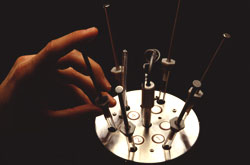High-throughput screening in chemical catalysis
Despite the significance and broad utility of chemical catalysis in the manufacture of chemicals and fuels, the search for new and improved catalysts continues to be an arduous trial-and-error process. In an effort to accelerate the process of searching for catalytic pathways from initial reactants to products, the COMBICAT project consortium relied on recent advances in computational methods. With the use of computers for data acquisition and analysis, high-throughput approaches to materials discovery experiments have been enabled. These include parallel rather than serial sample preparation and characterisation. Such experimentation is known as combinatorial analysis, whereby many nearly simultaneous experiments are performed and analysed at each step. At the Centre national de la recherche scientifique a parallel reactor system was designed with optional valve switching capabilities for heterogeneous catalysis testing. Loading variations in the 16 catalyst loaded reactors correspond to different space velocities and allow simultaneous kinetics measurements as these are independently exposed to multi-component gas mixtures. In addition, the system provides for time resolved product analyses and fast catalyst deactivation studies under atmospheric pressure. Detection of short-living, highly reactive intermediates was achieved under high vacuum when using a temporal analysis of products (TAP) reactor in the millisecond time regime. Allowing catalysis to rise above simple screening to the level of fundamental understanding of the reaction mechanisms, it can lead on to a fast path to rational catalyst design.

